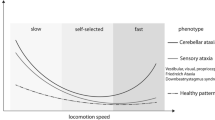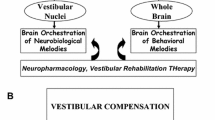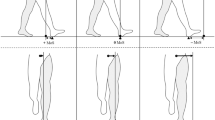Abstract
Gait coordination is generated by neuronal inter-connections between central pattern generators in the spinal cord governed by cortical areas. Malfunction of central vestibular processing areas generates vestibular symptoms in the absence of an identifiable peripheral vestibular system lesion. Walking in the dark enforces a coordinated afference primarily from the vestibular and somatosensory systems. We hypothesized that patients with aberrant central vestibular processing would demonstrate unique gait characteristics, and have impaired gait coordination compared with those patients with abnormal peripheral vestibular function and healthy controls. One-hundred and eighteen subjects were recruited. Peripheral vestibular function was determined based on laboratory and clinical examinations. Patients with abnormal central vestibular processing had normal peripheral vestibular function. Subjects were instructed to walk at a comfortable pace during three visual conditions; eyes open, eyes open and closed intermittently, and eyes closed. Both patient groups showed a similar spatiotemporal gait pattern, significantly different from the pattern of the healthy controls. However, only the central vestibular patient group had an abnormal coordination of gait as measured by the phase coordination index (PCI). There were no significant interactions between the groups and walking conditions. Peripheral vestibular deficits impair gait though our data suggest that it is the central processing of such peripheral vestibular information that has a greater influence. This impairment may be related to a neural un-coupling between the brain and central pattern generator of the spinal cord based on the abnormal PCI, which seems to be a good indicator of the integrity of this linkage.



Similar content being viewed by others
References
Angelaki DE, Gu Y, DeAngelis GC (2009) Multisensory integration: psychophysics, neurophysiology, and computation. Curr Opin Neurobiol 19:452–458
Arya KN, Pandian S (2014) Interlimb neural coupling: implications for poststroke hemiparesis. Ann Phys Rehabil Med 57(9–10):696–713
Assländer L, Peterka RJ (2016) Sensory reweighting dynamics following removal and addition of visual and proprioceptive cues. J Neurophysiol 116(2):272–285
Bent LR, Inglis JT, McFadyen BJ (2004) When is vestibular information important during walking? J Neurophysiol 92(3):1269–1275
Brandt T (2000) Vestibulopathic gait: you’re better off running than walking. Curr Opin Neurol 13(1):3–5
Brandt T, Strupp M, Benson J (1999) You are better off running than walking with acute vestibulopathy. Lancet 354(9180):746
Cohen HS, Mulavara AP, Peters BT, Sangi-Haghpeykar H, Bloomberg JJ (2012) Tests of walking balance for screening vestibular disorders. J Vestib Res 22(2):95–104
Cramer NP, Keller A (2006) Cortical control of a whisking central pattern generator. J Neurophysiol 96(1):209–217
Crane BT (2012) Direction specific biases in human visual and vestibular heading perception. PLoS One 7(12):e51383
Creath R, Kiemel T, Horak F, Jeka JJ (2002) Limited control strategies with the loss of vestibular function. Exp Brain Res 145(3):323–333
Davalos-Bichara M, Zuniga MG, Agrawal Y, Carey JP, Schubert MC (2014) Forward and backward locomotion in individuals with dizziness. Gait Posture 40(4):499–503
Dietz V (2003) Spinal cord pattern generators for locomotion. Clin Neurophysiol 14(8):1379–1389
Duysens J, Van de Crommert HWAA (1998) Neural control of locomotion; Part 1: the central pattern generator from cats to humans. Gait Posture 7:131–141
Ellis RG, Howard KC, Kram R (2013) The metabolic and mechanical costs of step time asymmetry in walking. Proc Biol Sci 280(1756):20122784
Forbes PA, Luu BL, Van der Loos HF, Croft EA, Inglis JT, Blouin JS (2016) Transformation of vestibular signals for the control of standing in humans. J Neurosci 36(45):11510–11520
Frank SM, Baumann O, Mattingley JB, Greenlee MW (2014) Vestibular and visual responses in human posterior insular cortex. J Neurophysiol 112(10):2481–2491
Grillner S, Wallén P, Saitoh K, Kozlov A, Robertson B (2008) Neural bases of goal-directed locomotion in vertebrates-an overview. Brain Res Rev 57(1):2–12
Hall CD, Herdman SJ, Whitney SL, Cass SP, Clendaniel RA, Fife TD, Furman JM, Getchius TS, Goebel JA, Shepard NT, Woodhouse SN (2016) Vestibular rehabilitation for peripheral vestibular hypofunction: an evidence-based clinical practice guideline. J Neurol Phys Ther 40(2):124–155
Horak FB, Diener HC, Nashner LM (1989) Influence of central set on human postural responses. J Neurophysiol 62(4):841–853
Horak FB, Nashner LM, Diener HC (1990) Postural strategies associated with somatosensory and vestibular loss. Exp Brain Res 82(1):167–177
Jahn K, Strupp M, Schneider E, Dieterich M, Brandt T (2000) Differential effects of vestibular stimulation on walking and running. NeuroReport 11(8):1745–1748
Kavounoudias A, Roll R, Roll JP (1998) The plantar sole is a ‘dynamometric map’ for human balance control. NeuroReport 9(14):3247–3252
Kirsch V, Keeser D, Hergenroeder T, Erat O, Ertl-Wagner B, Brandt T, Dieterich M (2016) Structural and functional connectivity mapping of the vestibular circuitry from human brainstem to cortex. Brain Struct Funct 221(3):1291–1308
Lempert T, Olesen J, Furman J, Waterston J, Seemungal B, Carey J, Bisdorff A, Versino M, Evers S, Newman-Toker D (2012) Vestibular migraine: diagnostic criteria. J Vestib Res 22(4):167–172
Marder E, Bucher D (2001) Central pattern generators and the control of rhythmic movements. Curr Biol 11(23):R986–R996
McGarvie LA, MacDougall HG, Halmagyi GM, Burgess AM, Weber KP, Curthoys IS (2015) The video head impulse test (vHIT) of semicircular canal function age dependent normative values of VOR gain in healthy subjects. Front Neurol 8(6):154
Meijer R, Plotnik M, Zwaaftink EG, van Lummel RC, Ainsworth E, Martina JD, Hausdorff JM (2011) Markedly impaired bilateral coordination of gait in post-stroke patients: is this deficit distinct from asymmetry? A cohort study. J Neuroeng Rehabil 8:23
Nashner LM, Black FO, Wall C 3rd (1982) Adaptation to altered support and visual conditions during stance: patients with vestibular deficis. J Neurosci 2(5):536–544
Perring S, Summers T (2007) Laboratory-free measurement of gait rhythmicity in the assessment of the degree of impairment and the effectiveness of rehabilitation in individuals with vertigo resulting from vestibular hypofunction. Physiol Meas 28:697–705
Peterka RJ (2002) Sensorimotor integration in human postural control. J Neurophysiol 88(3):1097–1118
Peterka RJ, Loughlin PJ (2004) Dynamic regulation of sensorimotor integration in human postural control. J Neurophysiol 91(1):410–423
Plotnik M, Hausdorff JM (2008) The role of gait rhythmicity and bilateral coordination of stepping in the pathophysiology of freezing of gait in Parkinson’s disease. Mov Dis 23:444–450
Plotnik M, Giladi N, Hausdorff JM (2007) A new measure for quantifying the bilateral coordination of human gait: effects of aging and Parkinson’s disease. Exp Brain Res 181:561–570
Plotnik M, Dagan Y, Gurevich T, Giladi N, Hausdorff JM (2011a) Effects of cognitive function on gait and dual tasking abilities in patients with Parkinson’s disease suffering from motor response fluctuations. Exp Brain Res 208:169–179
Plotnik M, Giladi N, Dagan Y, Hausdorff JM (2011b) Postural instability and fall risk in Parkinson’s disease: impaired dual tasking, pacing, and bilateral coordination of gait during the “ON” medication state. Exp Brain Res 210:529–538
Rossignol S, Dubuc R, Gossard JP (2006) Dynamic sensorimotor interactions in locomotion. Physiol Rev 86(1):89–154
Sadeghi H, Allard P, Prince F, Labelle H (2000) Symmetry and limb dominance in able-bodied gait: a review. Gait Posture 12:34–45
Schniepp R, Möhwald K, Wuehr M (2017) Gait ataxia in humans: vestibular and cerebellar control of dynamic stability. J Neurol. doi:10.1007/s00415-017-8482-3
Schubert MC, Herdman SJ, Tusa RJ (2002) Vertical dynamic visual acuity in normal subjects and patients with vestibular hypofunction. Otol Neurotol 23(3):372–377
Shik ML, Orlovsky GN (1976) Neurophysiology of locomotor automatism. Physiol Rev 56(3):465–501
Tarnutzer AA, Lasker AG, Zee DS (2013) Continuous theta-burst stimulation of the right superior temporal gyrus impairs self-motion perception. Exp Brain Res 230(3):359–370
Wang J, Lewis RF (2016) Abnormal tilt perception during centrifugation in patients with vestibular migraine. J Assoc Res Otolaryngol 17(3):253–258
Wuehr M, Nusser E, Decker J, Krafczyk S, Straube A, Brandt T, Jahn K, Schniepp R (2016) Noisy vestibular stimulation improves dynamic walking stability in bilateral vestibulopathy. Neurology 86(23):2196–2202
Zimmerman E, Barlow SM (2012) The effects of vestibular stimulation rate and magnitude of acceleration on central pattern generation for chest wall kinematics in preterm infants. J Perinatol 32(8):614–620
Author information
Authors and Affiliations
Corresponding author
Ethics declarations
Conflict of interest
The authors declare that they have no conflict of interest.
Rights and permissions
About this article
Cite this article
Gimmon, Y., Millar, J., Pak, R. et al. Central not peripheral vestibular processing impairs gait coordination. Exp Brain Res 235, 3345–3355 (2017). https://doi.org/10.1007/s00221-017-5061-x
Received:
Accepted:
Published:
Issue Date:
DOI: https://doi.org/10.1007/s00221-017-5061-x




